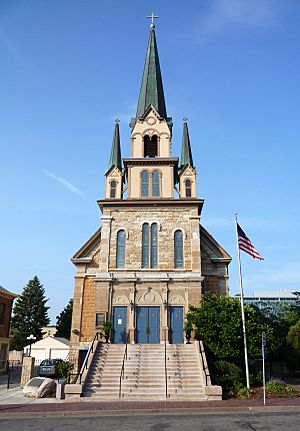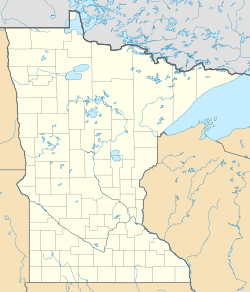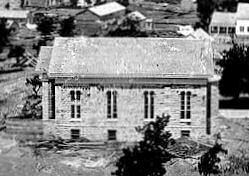Our Lady of Lourdes Catholic Church (Minneapolis, Minnesota) facts for kids
Quick facts for kids Our Lady of Lourdes Catholic Church |
|
|---|---|
 |
|
| 44°59′12.3″N 93°15′27.1″W / 44.986750°N 93.257528°W | |
| Location | One Lourdes Place Minneapolis, Minnesota |
| Country | United States |
| Denomination | Roman Catholic |
| Previous denomination | Universalist |
| History | |
| Former name(s) | First Universalist Church |
| Status | Parish church |
| Architecture | |
| Functional status | Active |
| Heritage designation | NRHP |
| Architect(s) | Carl F. Struck (parsonage) |
| Architectural type | Greek Revival; French Provincial; Gothic Revival |
| Years built | 1854–1857 |
Our Lady of Lourdes Catholic Church is a special Catholic church in Minneapolis, Minnesota. It is part of the Archdiocese of Saint Paul and Minneapolis. This church stands on the east bank of the Mississippi River. It is the oldest church building in Minneapolis that has been used continuously. It is also part of the important St. Anthony Falls Historic District.
Contents
A Look Back: Church History
Our Lady of Lourdes is the oldest church building in Minneapolis. People have used it without stopping since the mid-1800s. A group called the First Universalist Society of St. Anthony built it. They used it as a meeting hall from 1854 to 1857. This building was known as the First Universalist Church.
How the Church Got Its Name
In 1877, a group of Catholic French Canadians bought the church. They named it in honor of the Blessed Virgin Mary. She had recently appeared to Bernadette Soubirous in France. This event is known as Our Lady of Lourdes. Many churches around the world are named after these appearances. Our Lady of Lourdes in Minneapolis was the first in the U.S. with this name.
Changes to the Building Over Time
The Catholic church made big changes to the building. Between 1880 and 1883, they added new parts. These included a transept (the arms of the cross shape), an apse (a rounded end), and a front bell tower. This tower had three steeples. In 1914, a front entrance hall was added.
The Church's Place in History
The church is located near where Minneapolis first began. It stands close to the Pillsbury "A" Mill and the only natural waterfall on the Mississippi River. The building is not a National Historic Landmark. However, it was studied and drawn in 1934 for the Historic American Buildings Survey (HABS).
Keeping the Church Alive
The church's school used to speak French until about 1917. Over time, fewer people attended. By 1945, priests gave sermons only in English. The church almost closed in 1968. But the Minneapolis City Council convinced church leaders to keep it open. Today, Our Lady of Lourdes is one of 85 important buildings in the St. Anthony Falls Historic District. This district is listed on the National Register of Historic Places.
Unique Church Design: Architecture
The church's design is a mix of different architectural styles. The original builders, the Universalists, used limestone from nearby Nicollet Island. They built the church in the Greek Revival style. This style looks like an ancient Greek temple. The first building was about 3,000 square feet (280 m2) and cost $15,000.
Blending Styles: Catholic Additions
In the 1880s, the Catholic church added more parts. They included a special roof support called a V-frame beam truss. They also added the steeple, the transept, the bell tower, a sacristy (where priests prepare), and the vestibule. These new parts were built in French Provincial and Gothic Revival styles. The round shape of the main church area, called the nave, was inspired by the Chapel Royale at Versailles in France.
Our Lady of Lourdes Today
Today, the church teaches Catholic beliefs. It shares the morality and way of life taught by Jesus. It also offers sacraments and encourages prayer. Members believe in helping those who are sick or cannot attend services. The church offers classes called faith formation for people of all ages.
Supporting the Church's Future
To help fix up their church, the people there make and sell French Canadian tourtières. These are tasty savory meat pies. Church members have worked hard to protect the beautiful stained glass windows. They have also cared for the outside of the building. They protected the Blessed Virgin's grotto above the front entrance. Inside, they have restored the interior. They also fixed up the rectory (where the priests live) and added carillon bells. You can even take guided tours by making an appointment. The church's address used to be Prince Street, but now it is called Lourdes Place.
Gallery





